- NLI Research Institute >
- The Commercial Investment Real Estate Market in Tokyo
The Commercial Investment Real Estate Market in Tokyo
Masanori Oka
Font size
- S
- M
- L
In the government's land price surveys announced in September 1997, commercial property prices in central Tokyo rose for the first time since the collapse of the property bubble. Moreover, rents have bottomed out for superior properties that are new, large, and have good locations, raising expectations that they will start rising. Meanwhile, in auctions by the JNR Settlement Corporation, Asian companies have acquired properties in Shiodome and the Yaesu south exit of Tokyo Station at prices exceeding expectations. European and U.S. companies are also quietly making real estate acquisitions.
However, aside from the superior properties, the overall market remains depressed, with many properties having no prospect of becoming profitable and buildings remaining vacant despite massive rent declines. Progress has been absent in the liquidation of bad loans and collateral real estate, and the overall real estate market remains uncertain amid the weak economy.
As seen from market conditions in leased office buildings, the real estate market for investment is uneven and diverse. In this report, we focus on trends in the Tokyo market, the nation's largest in terms of real estate stock.
1. Office Leasing Market Trends
(1) Present Market Conditions
Vacancy rates in Tokyo's 23 wards peaked in September 1994, and have since continued to decline, dipping below 5 percent to 4.8 percent for the first time in five years (Figure 1). While newly advertised rents have finally bottomed out among large buildings in the central city area, rents in peripheral areas and for smaller buildings continue to fall (Figures 1 and 2).
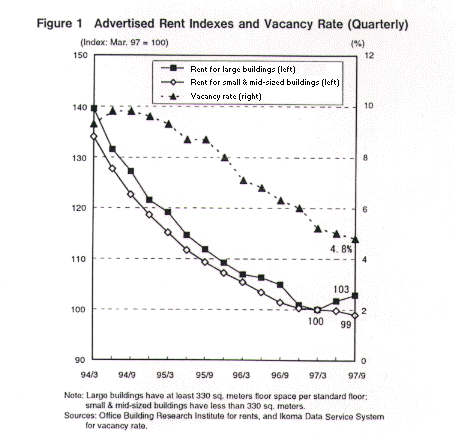
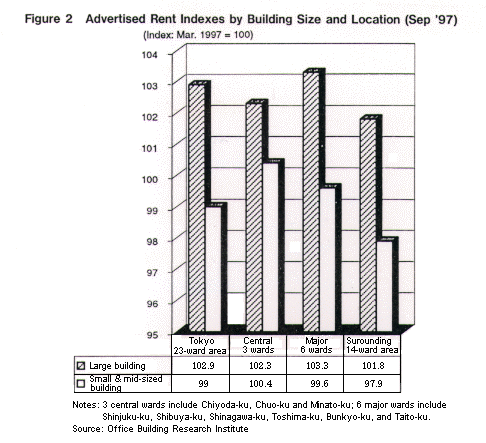
Office demand is concentrated in properties that satisfy three conditions: good location (central city, convenient to a train station, etc.), advanced functions (new and well equipped), and large size. The relative strength of demand is due to the scarcity of such properties and to the perception that rents are discounted. For example, according to a National Land Agency survey, less than 5 percent of the building stock in Tokyo's 23 wards consists of large buildings built since 1990 with a floor space of at least 30,000 square meters.
In addition, since the supply of new large office buildings is restrained, demand for offices is spreading beyond the superior properties described above to older, smaller buildings with good locations. However, demand remains depressed for medium and small buildings with poor locations, and for large buildings located away from the central city. It is thus difficult to grasp market conditions based on average values.
(2) Planned Construction of Office Buildings
Looking at the supply of office buildings in the 23 ward area over the past two decades, when we distinguish the pre-bubble period (1976-85) from the bubble and its collapse (1986-95), the average annual supply volume of 1 million square meters before the bubble had doubled to 2 million square meters in the latter period.
The commercial development plans for buildings with at least 5,000 square meters of floor space include many revived large-scale plans from the bubble era and buildings for own use. From 2000 onward, we can also see a high proportion of plans for offices in the three central wards (Figure 3).
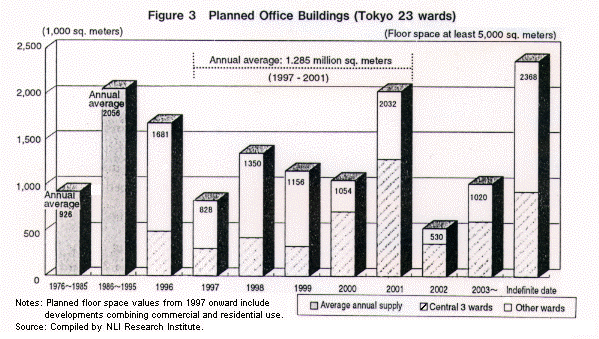
The average annual supply volume for the five-year period from 1997 to 2001 is 1.3 million square meters. This is two-thirds the level of the period from 1986 to 1995, and 1.3 times that of the pre-bubble period. A condition of excess supply may result depending on demand conditions.
For 2002 onward, construction plans total 4 million square meters including projects with indefinite construction dates. We must note that this comprises a potential pressure on supply.
Meanwhile, the construction of small and mid-sized buildings (under 5,000 sq. meters) will likely be quite restrained compared to the past because the collapse of the myth of land prices has made financial institutions conservative in real estate financing, while real estate companies burdened with massive interest-bearing debt have become pessimistic about undertaking business and subleasing.
(3) Office Demand Trends
Recent declines in vacancy rates indicate that office demand is growing. However, the growing demand is largely attributable to falling rents, and since rents have bottomed centered around good properties, further demand growth is unlikely.
Moreover, while demand is growing among foreign companies, according to a MITI survey over 99 percent of the employees of foreign companies are Japanese nationals, if new graduate hirings are excluded, the movement of personnel between companies is advancing. On the other hand, considering the ongoing restructuring in regulated sectors such as finance, the growth of overall demand for office space is not predicted to be large even with the growing presence of foreign companies.
However, while the future of office demand is unclear, the conditions sought of office buildings are steadily rising. This will cause differences in demand to grow based on the functions and location of buildings.
This trend is evident in the recent popularity of buildings meeting the three conditions of location, newness and size. Buildings that do not accommodate 24-hour usage or have advanced information networks are losing their competitiveness. The massive building stock constructed in the 1970s needs a thorough overhaul to be competitive with new buildings.
In addition, following the Hanshin Earthquake, many tenants are focusing on the level of earthquake resistance. Indeed, one-third of the office building stock in the 23-ward area is not up to the latest standards and thus significantly exposed to risks from natural disasters (Figure 4).
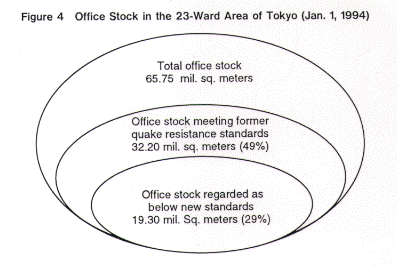
While the present market faces a shortage of good properties as overall supply and demand conditions tighten, many tenants appear not to be fully satisfied with their present buildings. New supply additions are thus likely to cause relocations.
Moreover, demand patterns are also shifting by location. Looking at the greater Tokyo metropolitan area, demand appears to be returning to office districts in the central city, with diverse patterns by location.
The return to central city areas can be attributed to a reevaluation of the advantages of economic concentration in central areas now that real estate prices have fallen. According to last year's survey by the National Land Agency, 51 percent of companies in the 23-ward area saw advantages to economic concentration in central areas, including proximity to customers and richness of information.
However, we can also see a pattern of diversification beyond the traditional Marunouchi and Otemachi district to a number of large office developments in other areas such as the seaside area (such as Shiodome), Shinagawa, and Shinjuku.
2. Trend in Commercial Land Prices
In the July 1997 standard land prices, Shinjuku and Ginza were among ten of the 171 commercial districts in the five central wards (Chiyoda-ku, Chuo-ku, Minato-ku, Shinjuku-ku, and Shibuya-ku) posting their first increase since 1991.
Looking at the eleven locations where the standard land value and official land value surveys overlap, we see that Shinjuku rose in January 1997 over the previous half-year, while two locations in Chiyoda-ku and Chuo-ku rose as of July (Figure 5). These three locations are the most expensive of the eleven locations (valued at over 7 million yen per sq. meter), indicating that the reversal in land prices is a phenomenon of prime real estate in the central city.
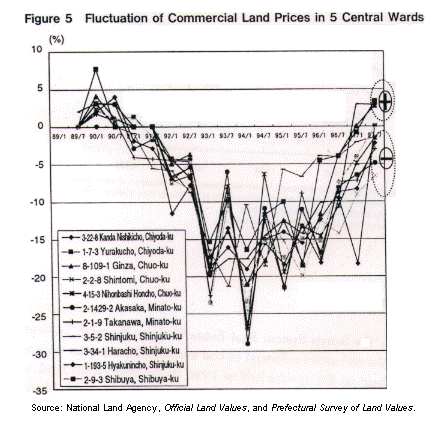
Looking at commercial land prices in the five central wards, each ward's variable coefficient (a measure of variance for comparison purposes; the standard deviation is divided by the mean value) has risen significantly since 1996, particularly for Chuo-ku (Figure 6). This indicates that price disparities are increasing in each ward depending on the area and specific property. However, it remains unclear whether the price reversal seen in prime properties will spread to other areas.
In land auctions by the JNR Settlement Corporation in the first half of 1997, while many properties fetched higher prices than expected, nearby land prices were not significantly affected.
In addition, due to the revival of office demand in central city areas, prices continue to decline in outlying areas such as Yokohama and Chiba.
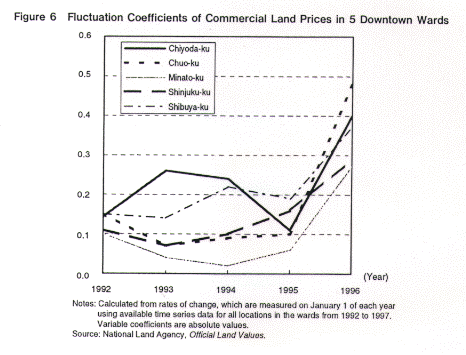
3. Trend in Real Estate Auctions
According to a survey by the Sanyu System Real Estate Finance Research Institute, in the auctions for liquidating the real estate collateral of bad loans, 100 properties were auctioned by the Tokyo District Court in the second half of 1996 (including vacant land, land with building, leased land, and condominiums), 49 percent of which were sold. Moreover, the auction prices were approximately 10 percent of the original collateral value.
Should properties held as collateral be liquidated on a scale substantial enough to alleviate the bad loan problem, the actual value of collateral held by companies would be clarified, causing real estate prices to fall.
4. Trends in Real Estate Transactions
(1) Real Estate Disposal by Companies
According to real estate sales trends (nationwide) of TSE listed companies between fiscal years 1993 and 1996, the number of transactions increases significantly from fiscal 1994 compared to fiscal 1993 (Figure 7). The reasons cited most frequently were to reduce debt and pursue restructuring (Figure 8).
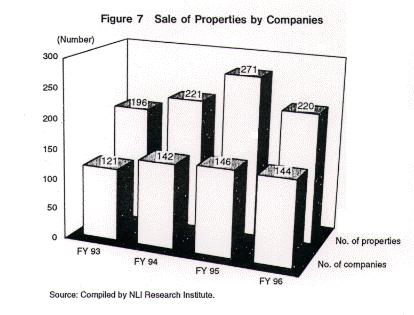
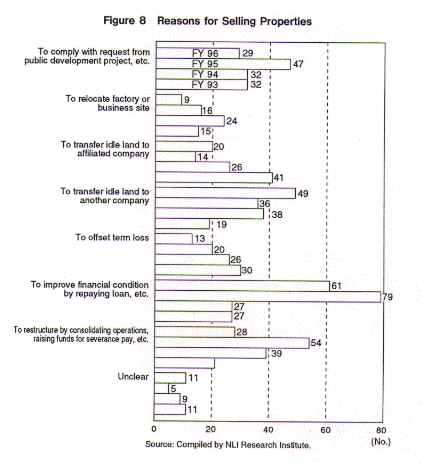
In addition, while public agencies accounted for about 10 to 20 percent of the purchases, most of the purchasers were affiliated companies and other companies in the private sector.
In any case, the disposal of real estate holdings is expected to remain at a high level in the future as financial institutions continue disposing of their bad loans and companies undo the excesses of the bubble era.
(2) Construction and Acquisition of Own Building
Companies have recently been showing a keen interest in acquiring or constructing buildings for their own use. The bidding for land under auction by the JNR Settlement Corporation confirms the strong latent demand of large companies to own their own office building. The primary purpose of ownership is varied, including reducing the cost of rent, improving business efficiency by integrating operations, and establishing a flagship store.
Looking at major building acquisitions and construction plans since 1995, the number of incidences is highest in 1997 at 44, while 1998 is highest in floor space (Figure 9).
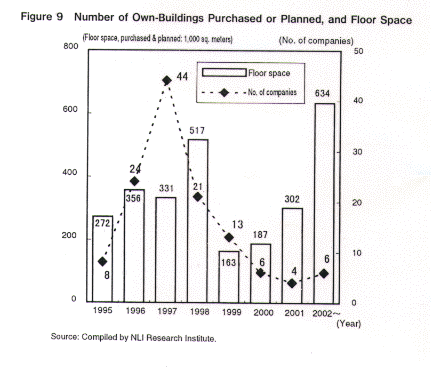
One factor behind this surge has been the recent decline in commercial land prices. However, it remains unclear whether ownership will continue to expand in the future, given that the land price myth has evaporated, long-term risks of real estate ownership have surfaced, and the cost-effectiveness of leasing versus ownership will be determined based on global standards.
(3) Real Estate Investment from Abroad
Until last year, the recent growth of foreign investment in real estate investment was often for the purpose of owning the company's own office building. However, in 1997 there has been a noticeable increase in construction and acquisitions for investment, as seen in the bidding for properties of the JNR Settlement Corporation (Table 1).
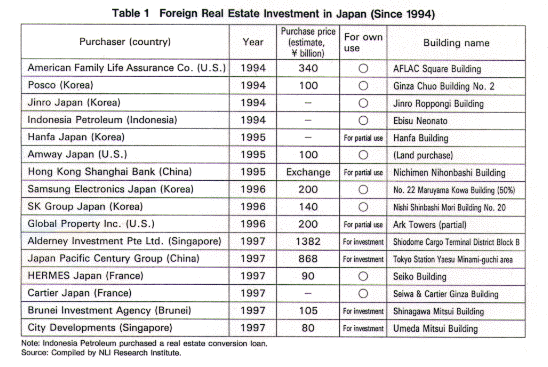
Factors encouraging Asian investors include the sentiment that commercial land prices are bottoming out, and that prices are low compared to back home. Moreover, they also have high expectations for Japan's economic prospects following the Big Bang financial reforms next spring.
However, considering the recent turmoil in Asia's financial markets, we should not expect investment from Asia to help invigorate the overall market. On the other hand, while the securitization of real estate held as collateral should spur investment from European and American investors, the high returns they will seek to offset the high risk will tend to pull real estate prices down.
However, foreign investors will remain cautious regarding properties other than the prime properties in central Tokyo and Osaka.
5. Status of Vacant Land
There is approximately 2.1 million sq. meters of unused or minimal-use land plots at least 250 sq. meters in size in Tokyo's three central wards. This is equivalent to seven times the area of the Shiodome redevelopment district (approximately 30 ha), or 12.1 percent of the private land area in the three wards.
By use, parking lots account for the largest proportion of this area at 40 percent, following by land under construction or planned for construction (33 percent), and vacant land (13.2 percent; Figure 10). If all this land were utilized to the maximum allowable extent, it would generate a potential of 9.95 million sq. meters of floor space.
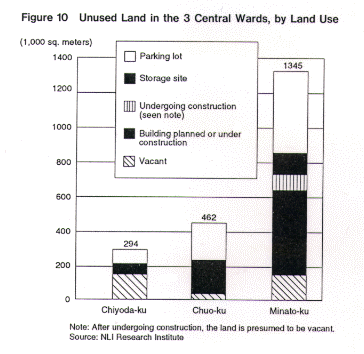
6. Conclusion
(1) Dual Structure of Real Estate Prices
As we have seen, there are reasons to be both optimistic and pessimistic about the real estate investment market. This indicates that the market is still in an adjustment phase, and that market conditions cannot be accurately captured by average values since the market has a dual structure. The question is whether the market's dual structure will be alleviated once the adjustment phase ends.
If the bubble's collapse−the first significant postwar decline in real estate prices−is viewed simply as a cyclical adjustment, we would infer that prices will head upward again once the adjustment is completed.
However, rising real estate prices up to the bubble era were supported by a growing population and economy. In the future, both the population economic growth are predicted to decline, providing no support for the land price myth. In addition, global economic activities and borderless flows of investment funds will move the real estate market toward global standards and greater transparency.
Due to these structural changes in the market environment, the basis of price formation in the investment real estate market is changing from a mythical belief in rising land prices to a rational approach based on use value. In this sense, it is symbolic that the release of official land values in 1995 finally shifted attention to the discounted cash flow method, and that the new overall land policy promotion outline of February 1997 altered the objective of land policy from the suppression of land prices to the effective utilization of land.
From this perspective, the dual price structure is not likely to disappear completely, and in fact may widen. Rents for superior properties should rise because of the sense that they fell too far in the confusion after the bubble's collapse. In this kind of market, even older buildings can regain their competitiveness and market value by enhancements to their earthquake resistance and facilities.
Moreover, when the price (land price) of a particular property rises, nearby land prices will no longer rise automatically regardless of use value.
In a free market, it is perfectly normal for price differences arise between products based on their quality. This is finally occurring in the real estate market.
However, for investment real estate to be securitized, and circulated at arbitrated rates with other financial products, the investment environment will need to be changed through measures such as constructing an information infrastructure and revising tax laws that impede transactions.
(2) Emergence of Business Risks
In the past, because real estate investment was practically assured of future hidden profits and capital gains, liquidity risks and other business risks peculiar to real estate were not regarded as problems. In addition, real estate companies assumed almost all business risks on the assumption that land prices would continue to appreciate rapidly. However, following the collapse of the land price myth and the experience of the Hanshin Earthquake, business risks specific to real estate have surfaced. (Table 2).
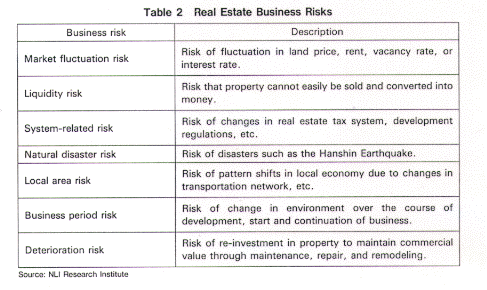
Real estate companies can no longer easily secure financing based on rising real estate values and their own creditworthiness, and will need to distribute and reduce business risks in the future.
Moreover, real estate prices in general reflect gains and can be expressed with the following formula: Price = Gains ÷ (Interest rate + Risk premium − Expected growth rate of gains). If a premium is added to the price to cover all business risks, ordinary investors will know that the real estate purchase price for business use must decline.
In any event, new real estate developments will be carefully screened. In addition, existing real estate properties for investment will need to maintain or increase their value by renewing functions to reduce risks associated with earthquakes and deterioration.
(3) Need for Expertise and Specialization
The real estate business and investment in real estate today require expertise and specialization in a variety of fields. In the future, real estate businesses will need to pursue specialization and the division of functions.
Future areas of specialization for real estate businesses include development, construction management, asset management and consulting, property management, and brokering. Issues such as the disposal of bad loans will require loan recovery abilities (servicer), while real estate securitization will require the ability to guarantee creditworthiness (risk capital) and issue ratings (rating agencies).
Mitsui Fudosan already set up the first domestic real estate investment advisory company in October 1997. Business tie-ups are also on the increase with foreign companies who have expertise.
With regard to the liquidation and securitization of nonperforming loans, Nippon Credit Bank tied up with Bankers Trust in April 1997, and Hokkaido Takushoku Bank and Barclays Bank followed suite in June. Prior to this, in December 1996 a data services company tied up with CB Commercial, the largest real estate services company in the U.S., to provide real estate brokering and consulting services; in January 1997, Mitsubishi Estate tied up with Cushman & Wakefield, a major U.S. real estate company; in June, Mitsui Real Estate Sales and Kinght Frank's Japanese subsidiary tied up in real estate consulting focusing on international brokering; and in October, Yasuda Trust Bank tied up with Goldman Sachs Realty Japan.
Such tie-ups are altering the structure of the real estate market, causing major changes in existing arrangements and opening up new business opportunities.
Masanori Oka
Research field
レポート紹介
-
研究領域
-
経済
-
金融・為替
-
資産運用・資産形成
-
年金
-
社会保障制度
-
保険
-
不動産
-
経営・ビジネス
-
暮らし
-
ジェロントロジー(高齢社会総合研究)
-
医療・介護・健康・ヘルスケア
-
政策提言
-
-
注目テーマ・キーワード
-
統計・指標・重要イベント
-
媒体
- アクセスランキング

















